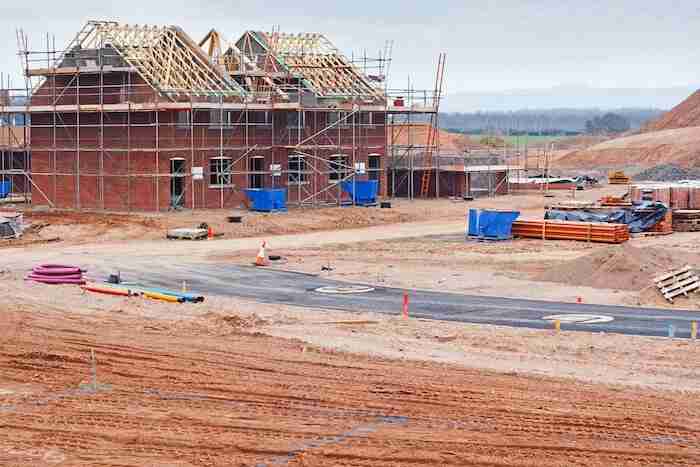Shelter in the U.S. is a problem…
Last week, I outlined how the cost of shelter is poorly measured by the Federal government. And how this mismeasurement contributes to an overestimation of inflation that distorts both perceptions about the economy and policy responses (you can read that column here).
But the fact that the price Americans pay to house themselves and their families is not measured correctly doesn’t mean it’s not high, or that there are enough homes for all the individuals and families that need one.
In fact, the cost of housing – both to buy and to rent a place to live – is extremely high right now, by historical standards. The price of homes has risen substantially over recent decades, even after adjusting for inflation. And that increase in prices has outpaced increases in household incomes.
Now to be clear, this is not typical inflation.
As I pointed out last week, about two-thirds of American households own their home, and more than 90% of those households have a fixed-rate mortgage. So for all of those people, shelter costs are not changing month to month (even though the flawed way shelter costs are measured suggests they are).
The real problem with rising costs of shelter is for renters – as rent does change frequently. And for people who don’t own a home but want to purchase one.
That primarily impacts two groups: low-income Americans and younger adults – the millennial generation, in particular. For these people, finding shelter adequate to their needs can be almost prohibitive.
So, what’s going on? There are a few factors causing this problem, and they are interrelated.
Demographics
Millennials (1981 to 1996) recently surpassed Baby Boomers (1946 to 1964) as the largest U.S. generation.
Yet Baby Boomers by and large are not moving out of their homes after their children move away. So while Millennials are now having kids and expanding, they own just 14% of mid- to large-size homes (three bedrooms or more), while Boomers, a large percentage of them empty nesters, own 28% of such homes.
That would be fine if enough new homes were being built to keep up with population growth… but they’re not.
New home construction fell dramatically across the country after the Great Recession of 2007-2009… and still hasn’t recovered.
That’s partly because that specific economic collapse began with a housing crash that put many homebuilders out of business, made the surviving builders much more conservative and drove banks to be much more careful with mortgage lending.
The number of single family homes built in the 2010s was the lowest of any decade since at least the 1950s. And all the while the U.S. population has continued to rise. So when you adjust for population growth, the decline in homebuilding is even more dramatic.

As you can imagine, that decline in home building kept a lot of households in the rental market, with more renters competing for a slow-growing supply of rental properties. Thus, availability today – both for rentals and homes for sale – is at near-record lows.
And housing affordability – which combines the availability of homes, home prices, and mortgage rates – fell to its lowest level last year in four decades. Just 16% of homes for sale last year were affordable for the typical U.S. household.
What Can Be Done?
How do we make sure there is enough housing for all Americans?
There’s no silver bullet here, but the overall solution is obvious. Because this is principally a supply side problem, more homes of all sorts – single family, multi-family, low-cost, public housing, etc. – need to be built.
And what can encourage that?
- Re-zoning: Part of the housing shortage is due to restrictive zoning laws. Three quarters of the available land in many cities is reserved for single-family homes. Eliminating – or at least relaxing – zoning laws for multifamily and public housing construction would relieve upward pressure on rents and low-income housing costs.
- Deregulation: Deregulating industry is not always the best idea, but in this case it’s a very good one. Land-use regulations like minimum lot sizes and building height limits decrease the supply of new housing, especially in denser areas. Easing these rules would produce more housing; it would also reduce commute times and traffic in many cities.
- Streamlining: The process to create a new housing development can take years. Simplifying things like one-stop permitting or priority processing for some kinds of housing can accelerate the process. Also, increased use of prefabricated materials – or even entire homes – can speed things up, from permit to sale.
- Upkeep: Preventing the loss of existing housing is also critical. The median age of existing homes in the U.S. is more than 40 years. Keeping these homes safe, livable and energy efficient requires money – and that can be facilitated through tax incentives (and in some cases subsidies).
Americans need more housing of all types, and all housing markets overlap.
If potential buyers can’t purchase a home, they remain renters; if larger existing homes don’t come on the market, buyers stay in smaller homes; and if new homes aren’t built, demand for existing homes drives prices higher.
That’s why I believe taking measures to increase the overall supply of housing is one thing Americans across the political spectrum should be able to agree on.
